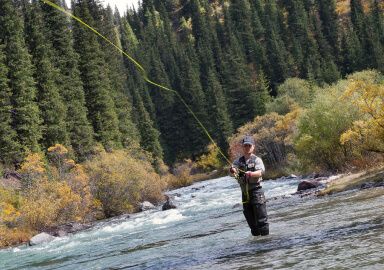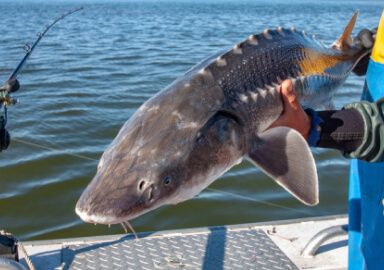White Sturgeon
It used to provide Native Americans with protein, and the rich with caviar, was decimated but slowly recovers: the white sturgeon, America’s largest freshwater fish.
View 2 listings
2
listings
–
price starting from
2
countries
–
to the nearest trip
Where and When?
Some of the large rivers, estuaries and coastal waters of the north-eastern Pacific Ocean are the domain of the white sturgeon. The species spawns, or used to spawn, in rivers from Monterey in California northwards to Alaska, and there are also landlocked populations in Lake Shasta and the upper Columbia River. White sturgeon spend most of their lives in estuaries or bays near large rivers and migrate upstream to spawn, usually a couple of years apart. Acoustic tagging shows that they are fairly inactive and sedentary in winters, when they are usually in relatively deep waters, with increased activity and upstream movement as temperatures rise.
Fishing for white sturgeon usually picks up in February to early March and the peak of catches is in late March or April, though there are often important local patterns of activity. The white sturgeon is believed to feed primarily at night, making early morning or late afternoon favorable times for fishing although in some locations they feed through the day.
About White Sturgeon
The white sturgeon (Acipenser transmontanus), North America's largest freshwater fish, was once a staple protein source for some Native American tribes living on the Pacific Coast. In the 1880s, the species was severely overfished for caviar, leading to drastically reduced populations. Recent recovery efforts have been hampered by habitat degradation and dam construction, with spawning significantly impacted in many areas due to blocked upstream breeding routes, resulting in slow and limited recruitment.
Characterized by a torpedo-shaped, elongate body with leathery skin and rows of large whitish scutes, white sturgeon are typically grey/brown above and paler below. They possess a small, toothless mouth under the head, with barbels positioned in front. Historically, they grew to enormous sizes, with the current maximum recorded size being 630 kg (1,390 lbs), though reports exist of a specimen weighing 816 kg (1,799 lbs). They mature between 11-34 years and can live over a century. Juvenile sturgeon feed on benthic invertebrates, shifting to larger prey like crustaceans and fish as they grow.
How to Catch?
White sturgeon fishing is usually conducted from riverbanks, estuaries, or small boats. While they can be caught using fly or spinning techniques, most are landed by means of bottom fishing with heavy spinning tackle and live or dead bait. White sturgeon are not aggressive predators and feed mostly on or very near the bottom, usually on soft substrates. As bottom feeders, they rely largely on smell and their barbels for locating food. Patience is essential, as white sturgeon often "play" with bait before fully committing; first you would probably have to wait a fair time for a gentle nibble, and then to wait a little more before the fish swallows the bait and swims off with it.
Circle hooks are recommended for effective hooking and easy release, especially in areas where consumptive fishing is restricted and barbless hooks are mandated. Effective baits include "smelly" options and live bait to attract and provoke bites. Common choices are crawfish, salmon eggs, anchovies, local fish, squid, or sand shrimp. Catching a white sturgeon often requires significant research, time, and effort, but landing a large specimen can be an unforgettable achievement. Hiring an experienced local fishing guide is usually the best way to have a great time fishing for white sturgeon.






